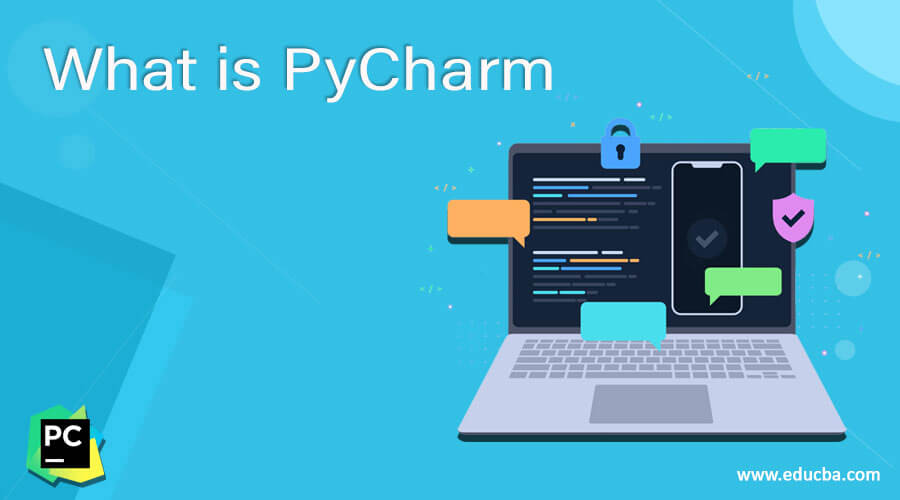Updated May 31, 2023

Introduction to PyCharm
One of the most common Python IDEs is PyCharm. This is because it is built by JetBrains, the developer behind the popular IntelliJ Concept IDE, one of the larger 3 Java IDEs, and the “most clever JavaScript IDE” WebStorm. There are many reasons why this is so. Another credible explanation is that it has the assistance of web creation by using Django. Numerous factors make PyCharm an integrated development environment for working with the Python programming language that is most comprehensive and complete. Numerous factors make PyCharm an integrated development environment for working with the Python programming language that is most comprehensive and complete.
What is PyCharm?
PyCharm is compatible with Linux, macOS, and Windows architectures, usable as a multi-platform program. PyCharm is one of the better IDEs in Python and supports the two versions of Python 2 (2.7) and Python 3 (3.5 and higher). PyCharm provides a host of plugins, kits, and tools to accelerate Python development and simultaneously minimize the effort to achieve the same. Additionally, you can tailor PyCharm according to your production needs and personal preferences. In addition to code analysis, PyCharm provides various functions. It was first publicly released in February 2010.
Where do we Use PyCharm?
Pycharm primarily used Python for programming and various platforms, including Windows, Linux, and macOS, for developing this IDE. The IDE provides code review, debugging tools, debugger, and version control tools. It also allows developers to create Python plugins using different APIs. The IDE lets us deal directly with different databases without combining them with other resources. It can also be created with that IDE, even though it is explicitly built for HTML, Python, JavaScript files, and CSS. Additionally, it offers a visually impressive user interface that can be personalized through plugins, allowing you to tailor it to your specific requirements.
Features
Given below are the features mentioned:
1. Project and Code Navigation
The code browsing feature makes navigating to a class, feature, or file much easier for developers. It also helps to minimize considerably the effort and time taken to edit and upgrade the Python code. Specialized project views and structural views are available readily. The lens mode helps developers thoroughly analyze and debug Python’s whole source code. Code navigation takes almost no time to find an element, vector, etc. Developers can switch between classes, files, and methods easily.
2. Intelligent Code Editor
PyCharm has an intelligent code editor that allows high-quality Python code. It increases code awareness and readability through different color schemes for keywords, functions, and classes, such as syntax and error highlighting. The code editor guides to completion of the current code and provides the smart code completion feature. Errors, problem detection, linter integration, and fast fixes are even easier.
3. Multi-technology Development
To build web applications, Python developers may also use PyCharm. Python IDE supports common web technology, such as CSS, TypeScript, HTML, CoffeeScript, JavaScript, and others. Moreover, PyCharm offers support for Python, template languages, and SQL.
PyCharm also provides live editing and helps developers to build/modify websites while simultaneously moving them live. Changes can also be followed on a web browser directly. Web frameworks are also available for development using NodeJS or AngularJS.
4. Code Navigation
The code browsing feature makes navigating to a class, feature, or file much easier for developers. It also helps minimize considerably the effort and time taken to edit and modify the Python code. Specialized project views and structure views of files are readily accessible. The lens mode helps a developer analyze and fully debug the whole source code of Python. Code navigation takes almost no time to find an element, vector, etc. Developers can switch between classes, files, and methods easily.
5. Refactoring
The PyCharm refactoring function helps to enhance a Python programmer’s internal structure without disrupting its external output. It is effective and swift to improve both local and global variables.
6. Availability of Integration Tools
PyCharm promotes the incorporation of several instruments. These instruments differ from helping to boost the productivity of code for the management of data science projects. Any of PyCharm’s most important integration methods are:
7. Google App Engine
The Google Search Server, or App Engine, is designed to create and host mobile apps as part of a PaaS and cloud computing network. It supports mobile apps with automated scale-up. Google Software Engine supports the technical version of PyCharm.
Recommended Articles
This is a guide to What is PyCharm. Here we discuss the introduction, where we use PyCharm, and features in detail. You may also have a look at the following articles to learn more –
